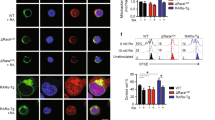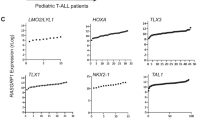Abstract
T cell anergy has been correlated with defective signaling by the GTPase Ras, but causal and mechanistic data linking defective Ras activity with T cell anergy are lacking. Here we used adenoviral transduction to genetically manipulate nonproliferating T cells and show that active Ras restored interleukin 2 production and mitogen-activated protein kinase signaling in T cells that were made anergic in vitro or in vivo. Diacylglycerol kinases (DGKs), which negatively regulate Ras activity, were upregulated in anergic T cells, and a DGK inhibitor restored interleukin 2 production in anergic T cells. Both anergy and DGK-α overexpression were associated with defective translocation of the Ras guanine nucleotide–exchange factor RasGRP1 to the plasma membrane. Our data support a causal function for excess DGK activity and defective Ras signaling in T cell anergy.
This is a preview of subscription content, access via your institution
Access options
Subscribe to this journal
Receive 12 print issues and online access
$209.00 per year
only $17.42 per issue
Buy this article
- Purchase on Springer Link
- Instant access to full article PDF
Prices may be subject to local taxes which are calculated during checkout









Similar content being viewed by others
Change history
03 November 2006
In the version of this article initially published, the equal contribution of the third author was omitted. The error has been corrected in the HTML and PDF versions of the article.
References
Schwartz, R.H. T cell anergy. Annu. Rev. Immunol. 21, 305–334 (2003).
Ramsdell, F., Lantz, T. & Fowlkes, B.J. A nondeletional mechanism of thymic self tolerance. Science 246, 1038–1041 (1989).
Staveley-O'Carroll, K. et al. Induction of antigen-specific T cell anergy: An early event in the course of tumor progression. Proc. Natl. Acad. Sci. USA 95, 1178–1183 (1998).
Fields, P., Fitch, F.W. & Gajewski, T.F. Control of T lymphocyte signal transduction through clonal anergy. J. Mol. Med. 74, 673–683 (1996).
Fields, P.E., Gajewski, T.F. & Fitch, F.W. Blocked Ras activation in anergic CD4+ T cells. Science 271, 1276–1278 (1996).
Li, W., Whaley, C.D., Mondino, A. & Mueller, D.L. Blocked signal transduction to the ERK and JNK protein kinases in anergic CD4+ T cells. Science 271, 1272–1276 (1996).
Kang, S.M. et al. Transactivation by AP-1 is a molecular target of T cell clonal anergy. Science 257, 1134–1138 (1992).
Rayter, S.I., Woodrow, M., Lucas, S.C., Cantrell, D.A. & Downward, J. p21ras mediates control of IL-2 gene promoter function in T cell activation. EMBO J. 11, 4549–4556 (1992).
Swan, K.A. et al. Involvement of p21ras distinguishes positive and negative selection in thymocytes. EMBO J. 14, 276–285 (1995).
Wan, Y.Y. et al. Transgenic expression of the coxsackie/adenovirus receptor enables adenoviral-mediated gene delivery in naive T cells. Proc. Natl. Acad. Sci. USA 97, 13784–13789 (2000).
Schaefer, B.C., Schaefer, M.L., Kappler, J.W., Marrack, P. & Kedl, R.M. Observation of antigen-dependent CD8+ T-cell/ dendritic cell interactions in vivo. Cell. Immunol. 214, 110–122 (2001).
Marks, R.E. et al. Differential Ras signaling via the antigen receptor and IL-2 receptor in primary T lymphocytes. Biochem. Biophys. Res. Commun. 312, 691–696 (2003).
Frauwirth, K.A., Alegre, M.L. & Thompson, C.B. CTLA-4 is not required for induction of CD8+ T cell anergy in vivo. J. Immunol. 167, 4936–4941 (2001).
Gajewski, T.F., Fields, P. & Fitch, F.W. Induction of the increased Fyn kinase activity in anergic T helper type 1 clones requires calcium and protein synthesis and is sensitive to cyclosporin A. Eur. J. Immunol. 25, 1836–1842 (1995).
Telander, D.G., Malvey, E.N. & Mueller, D.L. Evidence for repression of IL-2 gene activation in anergic T cells. J. Immunol. 162, 1460–1465 (1999).
Boussiotis, V.A., Freeman, G.J., Berezovskaya, A., Barber, D.L. & Nadler, L.M. Maintenance of human T cell anergy: blocking of IL-2 gene transcription by activated Rap1. Science 278, 124–128 (1997).
Lin, Y., Mettling, C. & Chou, C. Rap1-suppressed tumorigenesis is concomitant with the interference in ras effector signaling. FEBS Lett. 467, 184–188 (2000).
Sebzda, E., Bracke, M., Tugal, T., Hogg, N. & Cantrell, D.A. Rap1A positively regulates T cells via integrin activation rather than inhibiting lymphocyte signaling. Nat. Immunol. 3, 251–258 (2002).
Peterson, A.C., Marks, R.E., Fields, P.E., Imamoto, A. & Gajewski, T.F. T cell development and function in CrkL-deficient mice. Eur. J. Immunol. 33, 2687–2695 (2003).
Jeon, M.S. et al. Essential role of the E3 ubiquitin ligase Cbl-b in T cell anergy induction. Immunity 21, 167–177 (2004).
Miyake, S. et al. The Cbl protooncogene product: from an enigmatic oncogene to center stage of signal transduction. Crit. Rev. Oncog. 8, 189–218 (1997).
van Blitterswijk, W.J. & Houssa, B. Diacylglycerol kinases in signal transduction. Chem. Phys. Lipids 98, 95–108 (1999).
Ebinu, J.O. et al. RasGRP links T-cell receptor signaling to Ras. Blood 95, 3199–3203 (2000).
Dower, N.A. et al. RasGRP is essential for mouse thymocyte differentiation and TCR signaling. Nat. Immunol. 1, 317–321 (2000).
Sanjuan, M.A. et al. T cell activation in vivo targets diacylglycerol kinase α to the membrane: a novel mechanism for Ras attenuation. J. Immunol. 170, 2877–2883 (2003).
Topham, M.K. & Prescott, S.M. Diacylglycerol kinase ζ regulates Ras activation by a novel mechanism. J. Cell Biol. 152, 1135–1143 (2001).
Zhong, X.P. et al. Regulation of T cell receptor-induced activation of the Ras-ERK pathway by diacylglycerol kinase ζ. J. Biol. Chem. 277, 31089–31098 (2002).
Sanjuan, M.A., Jones, D.R., Izquierdo, M. & Merida, I. Role of diacylglycerol kinase α in the attenuation of receptor signaling. J. Cell Biol. 153, 207–220 (2001).
O'Keefe, J.P., Blaine, K., Alegre, M.L. & Gajewski, T.F. Formation of a central supramolecular activation cluster is not required for activation of naive CD8+ T cells. Proc. Natl. Acad. Sci. USA 101, 9351–9356 (2004).
Jiang, Y., Sakane, F., Kanoh, H. & Walsh, J.P. Selectivity of the diacylglycerol kinase inhibitor 3-[2-(4-[bis-(4-fluorophenyl)methylene]-1-piperidinyl)ethyl]-2, 3-dihydro-2-thioxo-4(1H)quinazolinone (R59949) among diacylglycerol kinase subtypes. Biochem. Pharmacol. 59, 763–772 (2000).
Peterson, A.C., Marks, R.E., Fields, P.E., Imamoto, A. & Gajewski, T.F. T cell development and function in CrkL-deficient mice. Eur. J. Immunol. 33, 2687–2695 (2003).
Outram, S.V., Crompton, T., Merida, I., Varas, A. & Martinez, A.C. Diacylglycerol kinase α activity promotes survival of CD4+8+ double positive cells during thymocyte development. Immunology 105, 391–398 (2002).
Zhong, X.P. et al. Enhanced T cell responses due to diacylglycerol kinase ζ deficiency. Nat. Immunol. 4, 882–890 (2003).
Layer, K. et al. Autoimmunity as the consequence of a spontaneous mutation in Rasgrp1. Immunity 19, 243–255 (2003).
Tzachanis, D. et al. Tob is a negative regulator of activation that is expressed in anergic and quiescent T cells. Nat. Immunol. 2, 1174–1182 (2001).
Anandasabapathy, N. et al. GRAIL: an E3 ubiquitin ligase that inhibits cytokine gene transcription is expressed in anergic CD4+ T cells. Immunity 18, 535–547 (2003).
Crespi, D. et al. Constitutive active p21ras enhances primary T cell responsiveness to Ca2+ signals without interfering with the induction of clonal anergy. Eur. J. Immunol. 32, 2500–2509 (2002).
Manning, T.C. et al. Antigen recognition and allogeneic tumor rejection in CD8+ TCR transgenic/RAG−/− mice. J. Immunol. 159, 4665–4675 (1997).
Abraham, C. & Miller, J. Molecular mechanisms of IL-2 gene regulation following costimulation through LFA-1. J. Immunol. 167, 5193–5201 (2001).
Gajewski, T.F., Joyce, J. & Fitch, F.W. Antiproliferative effect of IFN-γ in immune regulation. III. Differential selection of TH1 and TH2 murine helper T lymphocyte clones using recombinant IL-2 and recombinant IFN-γ. J. Immunol. 143, 15–22 (1989).
Fields, P.E. et al. B7.1 is a quantitatively stronger costimulus than B7.2 in the activation of naive CD8+ TCR-transgenic T cells. J. Immunol. 161, 5268–5275 (1998).
Wang, X., Zeng, W., Murakawa, M., Freeman, M.W. & Seed, B. Episomal segregation of the adenovirus enhancer sequence by conditional genome rearrangement abrogates late viral gene expression. J. Virol. 74, 11296–11303 (2000).
Rivas, F.V., O'Herrin, S. & Gajewski, T.F. CD28 is not required for c-Jun N-terminal kinase activation in T cells. J. Immunol. 167, 3123–3128 (2001).
Acknowledgements
We thank J. DeGregori for the human ubiquitin C promoter; J. Washington for assistance with mouse breeding; and C. Kao, F. Rivas, R. Shah and S. Bond for experimental assistance. Supported the National Institutes of Health (R01AI7919, P01CA97296 and R21AI59818), the Arthritis Foundation (T.F.G.) and Deutsche Forschungsgemeinschaft (R.M.).
Author information
Authors and Affiliations
Contributions
Y.Z. did experiments involving the cloning, transduction and expression of DGK-α and DGK-ζ, the effects of the DGK inhibitor, the generation of the dominant negative Cbl adenovirus and experiments associated with it, and participated in writing the manuscript; R.M. developed adenoviruses encoding active Ras and GFP and adenoviral transduction protocols, immunized mice and derived CAR transgenic TH1 clones, and showed that active Ras could restore IL-2 production by anergic TH1 cells; A.W.H. did gene expression profiling of anergic TH1 cells and confirmed the effects of active Ras on anergic T cells and effects of the DGK inhibitor; A.C.P. did all experiments with CrkL-deficient T cells; S.J. and I.B. worked together to accomplish the in vivo anergy experiments with 2C Rag2−/− T cells; K.P. did confocal microscopy of 2C cells conjugated with P815.B71 cells; S.S. and J.C.S. did immunoblot analysis of DGK-α and provided experimental guidance; T.F.G. conceived of and directed the project, oversaw all experiments, secured funding and actively participated in manuscript writing.
Corresponding author
Ethics declarations
Competing interests
The authors declare no competing financial interests.
Supplementary information
Supplementary Fig. 1
Recovery of IL-2 production in anergic TH1 cells does not require massive overexpression of constitutively active Ras. (PDF 107 kb)
Supplementary Fig. 2
CrkL and T cell anergy. (PDF 121 kb)
Supplementary Fig. 3
Expression of a dominant negative Cbl augments IL-2 production. (PDF 95 kb)
Supplementary Fig. 4
Inhibition of IL-2 production in anergic TH1 cells does not require massive overexpression of DGK-α. (PDF 118 kb)
Rights and permissions
About this article
Cite this article
Zha, Y., Marks, R., Ho, A. et al. T cell anergy is reversed by active Ras and is regulated by diacylglycerol kinase-α. Nat Immunol 7, 1166–1173 (2006). https://doi.org/10.1038/ni1394
Received:
Accepted:
Published:
Issue Date:
DOI: https://doi.org/10.1038/ni1394
This article is cited by
-
Optimization of the proliferation and persistency of CAR T cells derived from human induced pluripotent stem cells
Nature Biomedical Engineering (2022)
-
Rethinking peripheral T cell tolerance: checkpoints across a T cell’s journey
Nature Reviews Immunology (2021)
-
Ras isoforms: signaling specificities in CD40 pathway
Cell Communication and Signaling (2020)
-
Recent insights of T cell receptor-mediated signaling pathways for T cell activation and development
Experimental & Molecular Medicine (2020)
-
Reprogramming fatty acyl specificity of lipid kinases via C1 domain engineering
Nature Chemical Biology (2020)



